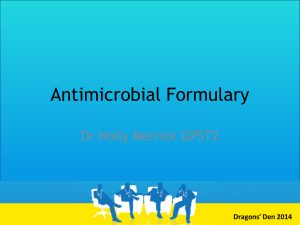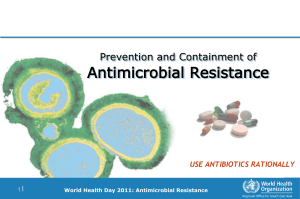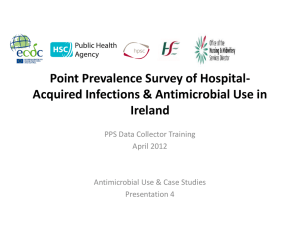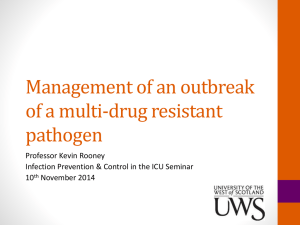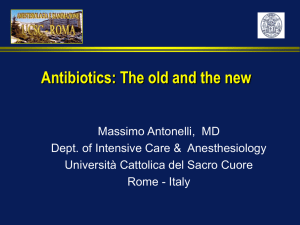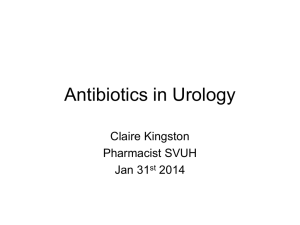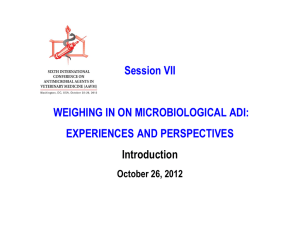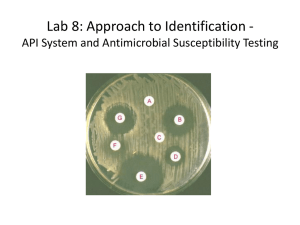041113--AntibioticStewadshipProgram
advertisement
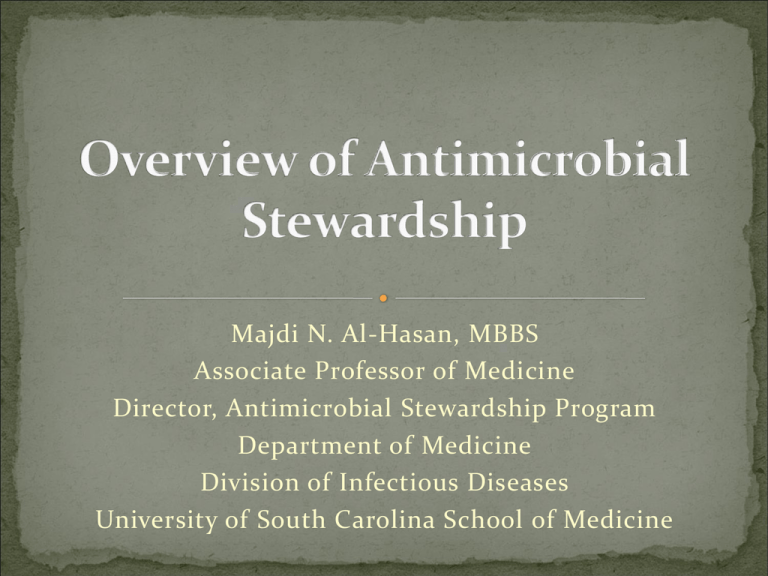
Majdi N. Al-Hasan, MBBS Associate Professor of Medicine Director, Antimicrobial Stewardship Program Department of Medicine Division of Infectious Diseases University of South Carolina School of Medicine I do not have any relevant relationships to disclose pertaining to this presentation today. Majdi N. Al-Hasan, MBBS Discuss the rationale for antimicrobial stewardship. Integrate evidence-based practices to improve antimicrobial therapy. Utilize tools to achieve antimicrobial stewardship goals. Increasing complexity of patient care over the past two decades: Aging population Increasing use of medical devices Central venous catheters Prosthetic heart valves Implantable cardiac devices Prosthetic joints Brain/spinal stimulators Increasing proportion of immune-compromised patients Advancements in cancer treatment Hematological and solid organ transplantation Corticosteroids and other immunosuppressive agents (TNF inhibitors, etc.) HIV Classification of infections based on site of acquisition: Hospital-acquired (nosocomial) Community-onset Healthcare-associated Community-acquired Inappropriate empirical antimicrobial therapy is associated with increased mortality in patients with serious infections: Sepsis Bloodstream infections (BSI) Paul M et al. AAC 2010; 54: 4851-63 Retamar P et al. AAC 2012; 56: 472-8 Kumar A et al. Duration of hypotension before initiation of effective antimicrobial therapy is the critical determinant of survival in human septic shock. Crit Care Med 2006 All this pressure has prompted an increase in the use of broad-spectrum antimicrobial therapy in very complex patients with serious infections. Unfortunately, that has been extrapolated for treatment of less complex patients with less serious infections. Excessive antibiotic use has driven antimicrobial resistance rates high both in hospitals and community. Vicious cycle of increasing use of antibiotics and further increase in antimicrobial resistance rates. El Atrouni et al. Temporal trends in the incidence of Staphylococcus aureus bacteremia in Olmsted County, Minnesota. Clin Infect Dis 2009. Al-Hasan et al. Antimicrobial resistance trends of Escherichia coli bloodstream isolates. J Antimicrob Chemother 2009. Increasing incidence rate of extended spectrum beta-lactamase (ESBL) producing E. coli and Klebsiella spp in Europe and USA. Carbapenem-resistant Enterobacteriaceae (CRE) are increasingly reported Klebsiella pneumonia carbapenemase (KPC) in 2001 New Delhi Metallo-beta-lactamase (NDM) in 2009 MMWR 2013; 62: 165-70 Hospitals continue to fight outbreaks of infections due to multi-drug resistant (MDR) organisms: MDR Pseudomonas aeruginosa MDR Acinetobacter baumanii Vancomycin-resistant enterococci (VRE) Despite all of this increase in complexity of care and antimicrobial resistance, there is paucity of antimicrobial development Very few novel antimicrobial agents for treatment of Gram-negative infections Free market rules New antibiotics are at early phases of development Making the best of currently available antimicrobial agents A 56-year old gentleman with ESRD on hemodialysis through HD catheter misses HD once due to feeling unwell. He is found to have a temperature of 101.8 F next HD session. One dose of IV vancomycin is administered after HD without obtaining any work up. He still reports subjective fever on the following HD session. HD is stopped prematurely due to relative hypotension. Another dose of IV vancomycin is given and he’s admitted to the hospital for observation. He remains febrile for 2 days in the hospital and still doesn’t feel better. IV vancomycin is switched to IV daptomycin. Still no cultures are obtained. On the 3rd night of hospital stay, he is transferred to the ICU due to hypotension requiring vasopressors. Blood cultures obtained in the ICU grow Gram- negative bacilli. Cefepime is added and HD catheter is removed. However, course progresses to severe sepsis (multiorgan failure) and septic shock (BP not responding to vasopressor therapy) and patient expires on hospital day #4. An infectious disease diagnosis is not complete unless all of the following components are established: Clinical syndrome (---itis) Microbiological etiology Host Mark Wilhelm, MD Mayo Clinic, Rochester, MN Empiricism will carry you for 48 hours at best, then you’re left alone in the dark without any guidance unless you’ve done the appropriate diagnostic work-up upfront: Cultures (blood, urine, sputum, CSF, bone, tissue) Antigens PCRs Possible directions of “blind empiricism”: Clinical improvement: can’t discharge home on broadspectrum IV antimicrobial regimen. Clinically stable: can’t continue broad-spectrum antibiotics due to side effects. Clinical deterioration: low-yield cultures after few days of antibiotics, can’t keep adding antibiotics, may be too little too late Making the best of currently available antimicrobial agents Determining microbiological etiology of infections A 72-year old lady with DM is admitted to the hospital with purulent drainage from superficial diabetic foot ulcer. On exam: T 99.4, BP 138/78, PR 82. 2x2 cm superficial ulcer in dorsal right big toe with some purulence, but no surrounding erythema or warmth. Peripheral pulses are present, but weak. Patient was started on broad-spectrum antibiotics, including IV vancomycin and piperacillintazobactam prior to surgical consultation for possible debridement. No evidence of osteomyelitis on MRI. On hospital day #4, she undergoes I&D of ulcer. Tissue cultures grow group B Streptococcus. However, broad-spectrum antibiotics are continued. On day #7 of hospitalization, she develops fever, watery diarrhea and leukocytosis of 27K. Diabetic foot ulcer site demonstrates continued clinical improvement. No need to start empiric antibiotics prior to surgical I&D and cultures in patients with diabetic foot infections, including chronic osteomyelitis in the absence of: Surrounding cellulitis High fever with hypotension Limb-threatening complications No need for empiric Gram-negative coverage in superficial diabetic foot ulcer infections Most superficial ulcer infections are caused by Gram- positive bacteria: staphylococci, streptococci and enterococci In non life- or limb-threatening infections, waiting for tissue Gram stain results is very unlikely to impact patient outcome (risk outweighs benefit) Early surgical debridement (source control) is more important than antibiotics After culture (and in vitro antimicrobial susceptibility testing) results are back, it is essential to reassess empirical regimen: Escalation: if clinically significant isolate is resistant to empirical regimen De-escalation: narrowest spectrum, safest, cheapest, most effective single antimicrobial agent for treatment of that particular infection In the given case, multiple opportunities were missed to de-escalate therapy: Gram-positive cocci on Gram stain: vancomycin monotherapy should be effective. Beta-hemolytic streptococci (groups A, B, C, etc): 100% susceptibility to penicillin G Making the best of currently available antimicrobial agents Determining microbiological etiology of infections Empirical therapy based on most probable etiology Early de-escalation of antimicrobial therapy A 23-year old lady with chronic sinusitis. She presents to clinic with low-grade fever, runny nose with yellowish drainage and sinus tenderness on exam. She received a short course of azithromycin for similar symptoms 3 months prior to this episode and amoxicilin-clavulanate 7 months earlier. She is prescribed levofloxacin this time. She returns to the office one month later with high fever, urinary frequency, dysuria and back pain. She has Rt constoverterbral angle tenderness on exam. Urine dipstick in the office is suggestive of UTI. Blood work up shows leukocytosis with left shift. Antimicrobial stewardship starts in the office Differentiating viral from bacterial upper respiratory tract infections Differentiating clinical failures from recurrences Use of end-of-the-line antibiotic for treatment of relatively minor infections can be costly Risk of colonization/infection with resistant organisms Potential loss of important antimicrobial options for treatment of future serious infections Potential loss of all oral antimicrobial options Complicated and increased cost of care (need for hospitalization, PICC lines, IV antibiotics, etc.) A 51-year old gentleman undergoes left hemi- colectomy for colon cancer. He receives ertapenem for pre-operative surgical site prophylaxis. He is discharged from the hospital to rehabilitation. Serious drainage is noted from the surgical wound at rehabilitation, so patient is started empirically on imipenem-cilastin. He is readmitted to the hospital 14 days after discharge with with fever and left lower abdominal pain. CT scan of abdomen and pelvis demonstrates fluid collection in LLQ. CT-guided aspiration is performed. Cx of fluid grew carbapenem-resistant Klebsiella pneumoniae (CRE) that is resistant to all tested antibiotics except colistin. Use of end-of-the-line antibiotic for relatively minor indications Ertapenem for surgical site prophylaxis! Source control and cultures prior to starting antibiotics High inoculum of bacteria and low antibiotic concentration in the abscess fluid create an optimal environment for development of antimicrobial resistance Patients with infections due to carbapenem- resistant Gram-negative bacilli are often left without any currently available safe or effective treatment options: CRE are often resistant to most available antibiotics Remaining options are either ineffective, nephrotoxic or both New agents are in early phases of development Making the best of currently available antimicrobial agents Determining microbiological etiology of infections Empirical therapy based on most probable etiology Early de-escalation of antimicrobial therapy Knowledge of local and regional antimicrobial resistance rates Stratifying patients at risk of infections due to resistant organisms Utilizing tools to determine severity of illness scores Antimicrobial stewardship programs Improve the outcome of hospitalized patients with serious infections Optimize empirical antimicrobial therapy Faster delivery of antimicrobial therapy Elimination of discordant definitive antimicrobial therapy Reduce side effects and toxicities associated with antimicrobial therapy, including C. difficile colitis Early de-escalation of antimicrobial therapy Discontinuation of antimicrobial therapy in patients without infections Discourage unjustified non-stratified use of broadspectrum antimicrobial therapy Reduce antimicrobial resistance individually and collectively Establish a culture of “culture-guided antimicrobial therapy” Emphasize the importance of source control for successful treatment of infections Stratify patients when making empirical antimicrobial treatment decisions Likely microbiological etiology of infection Site of infection acquisition Local and regional antimicrobial resistance rates Risk factors for antimicrobial resistance Severity of illness scores Re-evaluate empirical antimicrobial regimen based on: Gram stain Culture results In vitro antimicrobial susceptibility testing Clinical response Education Group sessions One on one Data generation and dissemination Local and regional antibiograms Microbiological etiology of common infections Outcome of patients with serious infections Research Clinical therapeutics Antimicrobial resistance trends Effectiveness of clinical interventions Development of local guidelines and pathways for management of common/serious infections Power plans Antimicrobial Stewardship and Support Team Pager # 352-1322

